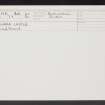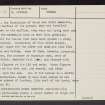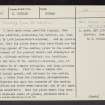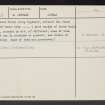Scheduled Maintenance
Please be advised that this website will undergo scheduled maintenance on the following dates: •
Tuesday 3rd December 11:00-15:00
During these times, some services may be temporarily unavailable. We apologise for any inconvenience this may cause.
Dunbar Castle
Burial Ground (Early Medieval)
Site Name Dunbar Castle
Classification Burial Ground (Early Medieval)
Canmore ID 57627
Site Number NT67NE 26
NGR NT 67793 79209
NGR Description NT c. 67 79
Datum OSGB36 - NGR
Permalink http://canmore.org.uk/site/57627
- Council East Lothian
- Parish Dunbar
- Former Region Lothian
- Former District East Lothian
- Former County East Lothian
NT67NE 26 c. 67 79
See also NT67NE 8.
'I have made every possible inquiry, that circumstances admitted, concerning the Coffins, etc, that were dug up by Lord Lauderdale's workmen; and my opinion is confirmed, that the place where they were found was the common burying ground of the castle, prior to the erection and establishment of the present church and churchyard of Dunbar: for, although neither history, nor tradition, establishes the date of the castle's erection, yet, it is well known to be of remote antiquity, and long previous to the present church. That it was a common and established burial ground, and belonged to the castle, is probable, I think from the following circumstances: that its situation was upon the outworks of the castle; that the coffins and bones were numerous, and of all ages, many of them children's; that the place where they were found was a circular piece of ground, enclosed with a stone wall, the foundation of which was still complete, within the surface of the ground, that was levelled: with respect to the coffins, they were all lying east and west, and the materials such as have been generally found in all the tumuli that have been opened in every part of Scotland: consisting of thin broad stones, set on their edges for the sides and ends, and laid flat for the top and bottom; some of them, however, prepared, as I suppose, for persons of superior rank, were of superior polish, cemented with lime, and adorned with scriptural figures on the lid and ends; these figures were a sun on the east end, and swords, and other ornaments, upon the lid. One of the bodies in a coffin of this description, seems to have been buried in his clothes, as pieces of leather, like part of his boots, were found within it.
One circumstances seems somewhat unaccountable; that, in a particular place, a great number of thigh and leg bones were found lying together, without the other parts of the human body a good nmber of stone balls were found, rounded by art, of different, some of them as large as our 24 pounders at present, and others of half that size; some of them are preserved.'
Dr Carfrae letter to G Chalmers (Archaeologia 1803).
No additional information.
Visited by OS (JLD) 11 September 1962














